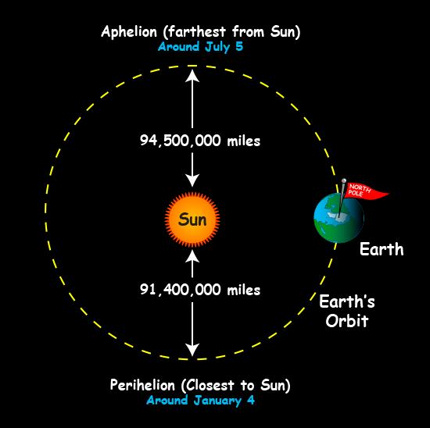[ Skywatchers ] [ Main Menu ]
47852

From: Eve, [DNS_Address]
Subject: Earth at perihelion – closest to sun – on January 2-3
URL: https://earthsky.org/tonight/earth-comes-closest-to-sun-every-year-in-early-january/
|
EXCERPT: Earth’s orbit around the sun isn’t a circle. Instead, it’s an ellipse, like a circle someone sat down on. So, it makes sense that Earth has closest and farthest points from the sun each year. For 2024, our closest point comes at 1 UTC on January 3 (8 p.m. CDT on January 2). This closest Earth-sun distance is called perihelion, from the Greek roots peri meaning near and helios meaning sun. In early January, we’re about 3% closer to the sun – roughly 3 million miles (5 million km) – than we are during Earth’s aphelion (farthest point) in early July. That’s in contrast to our average distance of about 93 million miles (150 million km). NASA Earth Fact Sheet with precise perihelion and aphelion distances. So, Earth is closest to the sun every year in early January, when it’s winter for the Northern Hemisphere. And we’re farthest away from the sun in early July, during our Northern Hemisphere summer. |
Responses:
[47859]
47859
From: georg, [DNS_Address]
Subject: Re: Earth at perihelion – closest to sun – on January 2-3
|
so, where did the 23 and some degree tilt come from? this is the north polar centric view, what does the south polar centric view look like? and when you watch the sky do you see how the jet stream has a kink in it and the "westerlies" no longer blow from west to east across the northern tier? the weather is changing and so is the climate and drought is no becoming a factor in the grain belt and corn belt and soy belt ... whole earth is the view we should have ... earth and sky ... can't have one without the other |
Responses:
None
[ Skywatchers ] [ Main Menu ]